How to loose your customers
Last year, Barclays offered a fairly compelling home insurance proposition. They beat your current deal by £50. A friend took advantage of this offer. A year later they sent the renewal documents through. Being a reasonably busy and disorganised guy, he never got round to renewing the insurance until six weeks after it had expired. He rang the call centre explaining that he wanted to renew; yes, he had been without insurance for the past six weeks, but wanted to take advantage of the premium they had quoted. But Barclays refused to honour the renewal quotation. They told him that as the policy was not continuous he would be treated as a new customer. The policy he was now being quoted was significantly more than on the renewal letter. He asked to speak to a manager and was again told the renewal quote was no longer available.
So he went to Money Supermarket and got a competitive deal from Halifax. Indeed it was much more competitive; five times cheaper than the Barclays call centre was offering.
So despite all the cost of acquisition, Barclays were quite happy to loose an otherwise loyal customer who was prepared to pay their original quotation. They then gave him good reason to shop around and have now lost him for good.
If there is a moral in this story, it is when developing new products, propositions or supporting technology, play out all potential scenarios. Customers are not always rational beings, they don’t always behave in the way you assume they will. Don’t just design for the “happy path”, but challenge your thinking with “what if” scenarios for what happens in the real world outside your idealised customer model.



